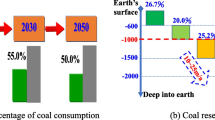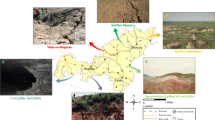Abstract
Solid backfill mining for coal pillar recovery in industrial squares has to ensure that the mine infrastructure, such as the shafts and substations, is not degraded or has its utility impaired by that mining. At the same time, it is important to recover as much coal as possible. As a result, it is necessary to predict mining subsidence during solid backfilling mining of coal pillars in industrial squares and to optimize the design of the working faces. At the Baishan coal mine in Anhiu province, China, there are thick layers of unconsolidated overburden above the coal seam so it is not appropriate to use the surface subsidence prediction method of equivalent mining height to predict subsidence during the mining of the coal pillars there. In order to find a reasonable coal pillar recovery scheme for the Baishan mine, a numerical simulation method is used to determine the relationships between the compression ratio of the backfilling material and the surface subsidence prediction parameters. Research was done to determine the appropriate parameters, and based on the final prediction parameters and taking the mandated protection standards for buildings and structures into account, surface subsidence is predicted and a backfill mining scheme for pillar recovery is proposed. The results show that of the six mining schemes considered, scheme 5 is the best scheme for coal pillar recovery in the industrial square at the Baishan mine. The research results are significant for similar mines with thick unconsolidated overburden anywhere in the world.









Similar content being viewed by others
References
Aksoy, C. O. (2002). Numerical modelling for the recovery of protecting pillars in Soma District (doctoral dissertation, Ph. D. Thesis, Dokuz Eylul Univ. Graduate Sch. of Nat. and Appl. Sci., Turkey, 97-101)
Aksoy CO, Kose H, Onargan T, Koca Y, Heasley K (2004) Estimation of limit angle using laminated displacement discontinuity analysis in the Soma coal field, Western Turkey. Int J Rock Mech Min Sci 41(4):547–556. https://doi.org/10.1016/j.ijrmms.2003.01.002
Aksoy CO, Geniş M, Aldaş GU, Özacar V, Özer SC, Yılmaz Ö (2012) A comparative study of the determination of rock mass deformation modulus by using different empirical approaches. Eng Geol 131:19–28
Baryakh AA, Telegina EA, Samodelkina NA, Devyatkov SY (2005) Prediction of the intensive surface subsidences in mining potash series [J]. J Min Sci 41(4):312–319. https://doi.org/10.1007/s10913-005-0096-y
Guo GL, Zhu XJ, Zha JF (2014) Subsidence prediction method based on equivalent mining height theory for solid backfilling mining. Trans Nonferrous Met Soc China 24(10):3302–3308
Guo W, Xu F (2016) Numerical simulation of overburden and surface movements for Wongawilli strip pillar mining. Int J Min Sci Technol 26(1):71–76. https://doi.org/10.1016/j.ijmst.2015.11.013
He GQ, Yang L, Ling G, Jia C, Hong D (1991) Mining subsidence science. China University Mining Technology Press, Xuzhou
Huang YL, Zhang JX, Zhang Q et al (2011) Backfilling mining technology of substituting waste and fly ash for coal underground in china coal mining area. Environ Eng Manag J 10(6):769–775
Hu HF (2012) Research on surface subsidence regularity and prediction under composite mediums with different thickness rations. PhD thesis. Taiyuan University of Technology
Jin L S, Mou J S (2000). Regulations on mining and coal pillar design under building, water body, railway and main shaft Coal Industry Press. 20–45
Jing L (2003) A review of techniques, advances and outstanding issues in numerical modelling for rock mechanics and rock engineering. Int J Rock Mech Min Sci 40(3):283–353. https://doi.org/10.1016/S1365-1609(03)00013-3
Li SX (2012). Study on the developing design of gangue filling system underbuildings for fully mechanized face in tang-shan mine. PhD thesis. Liaoning Technical University
Li HZ, Zhao BC, Guo GL, Zha JF, Bi JX (2016) The influence of an abandoned goaf on surface subsidence in an adjacent working coal face: a prediction method. Bull Eng Geol Environ:1–11
Miao XX (2010) Principle of underground pressure control in fully-mechanized coal mining with solid filling and force analysis of mining support. J Chin Univ Mining Technol 39(6):795–801
Miao XX, Zhang JX, Guo GL (2010) Study on waste-filling method and technology in fully-mechanized coal mining. J China Coal Soc 35(1):1–6
Marschalko M, Yilmaz I, Bednárik M, Kubečka K (2011) Variations in the building site categories in the underground mining region of Doubrava (Czech Republic) for land use planning. Eng Geol 122(3):169–178. https://doi.org/10.1016/j.enggeo.2011.05.008
Marschalko M, Yilmaz I, Křístková V, Fuka M, Bednarik M, Kubečka K (2012a) Determination of actual limit angles to the surface and their comparison with the empirical values in the Upper Silesian Basin (Czech Republic). Eng Geol 124:130–138. https://doi.org/10.1016/j.enggeo.2011.10.010
Marschalko M, Yilmaz I, Bednárik M, Kubečka K (2012b) Influence of underground mining activities on the slope deformation genesis: Doubrava Vrchovec, Doubrava Ujala and Staric case studies from Czech Republic. Eng Geol 147:37–51
Miao XX (2012) Progress of fully mechanized mining with solid backfilling technology. J China Coal Soc 37(8):1247–1255
Mahdi S, Li CC (2012) Numerical modelling of longwall mining and stability analysis of the gates in a coal mine. Int J Rock Mech Min Sci 51:24–34
Nicieza CG, Fernández MIÁ, Díaz AM (2005) The new three-dimensional subsidence influence function denoted by n–k–g [J]. Int J Rock Mech Min Sci 42(3):372–387. https://doi.org/10.1016/j.ijrmms.2004.12.003
Rafie M, Namin FS (2015) Prediction of subsidence risk by FMEA using artificial neural network and fuzzy inference system. Int J Min Sci Technol 25(4):655–663. https://doi.org/10.1016/j.ijmst.2015.05.021
Singh RP, Yadav RN (1995) Prediction of subsidence due to coal mining in Raniganj coalfield, West Bengal, India. Eng Geol 39(1–2):103–111. https://doi.org/10.1016/0013-7952(94)00062-7
Soni AK, Singh KKK, Prakash A (2007) Shallow cover over coal mining: a case study of subsidence at Kamptee Colliery, Nagpur, India [J]. Bull Eng Geol Environ 66(3):311–318. https://doi.org/10.1007/s10064-006-0072-z
Shi L (2016). Method of seeking senate probability integration under conditions of thick alluvium. PhD thesis. Anhui University of Science and Technology
Vakili A, Hebblewhite BK (2010) A new cavability assessment criterion for longwall top coal caving. Int J Rock Mech Min Sci 47(8):1317–1329. https://doi.org/10.1016/j.ijrmms.2010.08.010
Wang L, Zhang XN, Guo GL, Cha JF (2014) Research on surface subsidence prediction model of coal mining with solid compacted backfilling. Rock Soil Mech 35(7):1973–1978
Zhu WJ, Ma W, Hong D (1984) Creditability analysis of rock strata movement law by using similar material simulation. Mining Survey 03:10–18
Zha JF (2008) Study on the foundational problems of mining subsidence controlled in waste stow. PhD thesis. China University of Mining and Technology
Zhang J, Zhang Q, Sun Q (2015) Surface subsidence control theory and application to backfilling coal mining technology. Environ Earth Sci 74(2):1439–1448. https://doi.org/10.1007/s12665-015-4133-0
Acknowledgments
We thank David Frishman, PhD, from Liwen Bianji, Edanz Group China (www.liwenbianji.cn/ac), for editing the English text of a draft of this manuscript.
Funding
This work was funded by the Primary Research and Development Plan of Shandong Province (Grant No. 2017GGX90102), the Project of Shandong Province Higher Educational Science and Technology Program (Grant No. J17KA217), and the NASS Key Laboratory of Land Environment and Disaster Monitoring (NO. LEDM2014B04).
Author information
Authors and Affiliations
Corresponding authors
Rights and permissions
About this article
Cite this article
Ma, C., Li, H. & Zhang, P. Subsidence prediction method of solid backfilling mining with different filling ratios under thick unconsolidated layers. Arab J Geosci 10, 511 (2017). https://doi.org/10.1007/s12517-017-3303-7
Received:
Accepted:
Published:
DOI: https://doi.org/10.1007/s12517-017-3303-7




